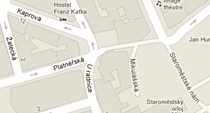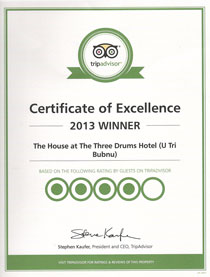Franz Kafka - Museum
 The long-term exhibition The City of K. Franz Kafka and Prague opens in Prague in the summer period, which seems to have had a fateful influence on Kafka. On 3rd July 1883 he was born here, on the 3rd June 1924 he died in the Kierling sanatorium and on 11th June he was buried in Prague.
The long-term exhibition The City of K. Franz Kafka and Prague opens in Prague in the summer period, which seems to have had a fateful influence on Kafka. On 3rd July 1883 he was born here, on the 3rd June 1924 he died in the Kierling sanatorium and on 11th June he was buried in Prague.
The symbiosis between Kafka’s life path, his work and Prague has been explored from all angles over the long decades of Kafkian research.
Kampa
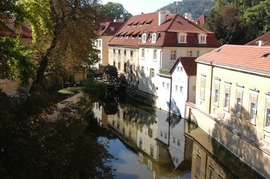 One of Prague’s islands on the Vltava, separated from the river by the well-known Čertovka creek (Devil’s Stream), which serves as a mill-race to this day. Kampa originated during the construction of an artificial channel for water mills.
One of Prague’s islands on the Vltava, separated from the river by the well-known Čertovka creek (Devil’s Stream), which serves as a mill-race to this day. Kampa originated during the construction of an artificial channel for water mills.
Visitors seek out this place for quiet strolls through the romantic corners of Prague and for the variety of cultural and historical monuments. The northern part of the island, by the Čertovka stream, is called the Venice of Prague.
Charles Bridge
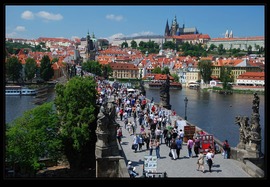 Guarding the route between Old Town and Little Quarter for centuries, Charles Bridge is undoubtedly one of the most-visited places in Prague.
Guarding the route between Old Town and Little Quarter for centuries, Charles Bridge is undoubtedly one of the most-visited places in Prague.
An ancient bridge with an unforgettable view of Prague Castle and the Vltava, the mother of rivers. It was here that royal procession walked; it was here that history unfolded.
Palladium
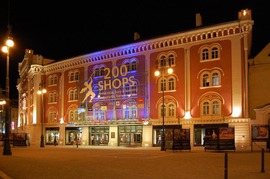 On 25th October 2007, a new shopping centre in the very heart of the capital city opened its gates to Prague's inhabitants.
On 25th October 2007, a new shopping centre in the very heart of the capital city opened its gates to Prague's inhabitants.
The Palladium Shopping Centre at Republic Square offers over 170 shops and tends to be described as the Temple of Consumerism or the Shrine of Shopping.
Pařížská Street
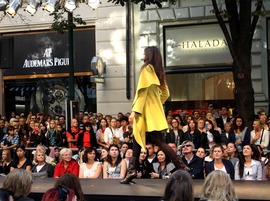 The street originated during the clearance of the Jewish Town and bears the name of Paris, resembling Parisian boulevards. Nowadays, Pařížská Street is a luxury corridor with many haute-couture stores and restaurants.
The street originated during the clearance of the Jewish Town and bears the name of Paris, resembling Parisian boulevards. Nowadays, Pařížská Street is a luxury corridor with many haute-couture stores and restaurants.
Pařížská Street is called „Prague’s most expensive street“, as the rental prices of the flats and especially shops are indeed the highest in the metropolis (and, consequently, in the whole of the Czech Republic), as well as the 14h most expensive in the world.
Petřín
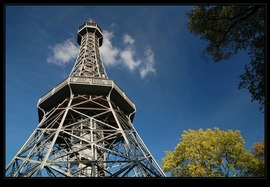 One of Prague’s most popular tourist destinations is a hill in the very centre of the city, called Petřín. This prominent hill provides a breathtaking view of the whole of Prague.
One of Prague’s most popular tourist destinations is a hill in the very centre of the city, called Petřín. This prominent hill provides a breathtaking view of the whole of Prague.
Petřín is full of attractions and monuments. The Petřín Watch-tower is an impressive building, towering near Prague Castle. The watch-tower represents one of the landmarks of the famous Prague panorama.
Prague Castle
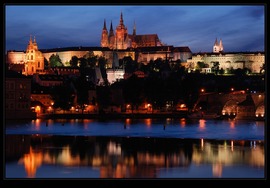 Prague Castle - an ancient symbol of the Czech State – is the most significant Czech monument and, simultaneously, one of the country's major cultural institutions. The Castle was probably founded as early as the year 880 by Duke Bořivoj of the Přemyslid dynasty.
Prague Castle - an ancient symbol of the Czech State – is the most significant Czech monument and, simultaneously, one of the country's major cultural institutions. The Castle was probably founded as early as the year 880 by Duke Bořivoj of the Přemyslid dynasty.
According to the Guiness Book of Records, Prague Castle is the largest continuous castle complex in the world, stretching across an area of almost 70 000 m2, and it is also recorded in the UNESCO World Heritage List.
Old Town Square
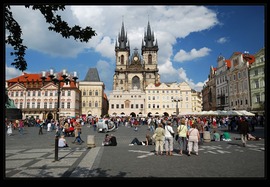 According many tourists, Old Town Square is the most beautiful square in Europe. Tourists visit this square especially for the Astronomical Clock to watch its moving figures of the Apostles.
According many tourists, Old Town Square is the most beautiful square in Europe. Tourists visit this square especially for the Astronomical Clock to watch its moving figures of the Apostles.
The square, however, is far more interesting and mysterious, boasting a very long and unique history. Having witnessed many historical events, it remains a hub all events in Prague to this day.
Old Town Astronomical Clock
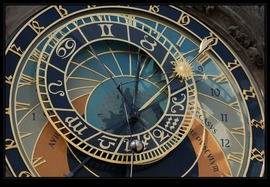 One of Prague’s most mysterious places, attracting thousands of tourists on a daily basis, is the Astronomical Clock on the Old Town Hall. According to some researchers, it can be noticed that the Astronomical Clock is divided into four imaginary levels. Ancient alchemists and astrologers believed that the Universe is composed of four elements: earth, water, air and fire. These elements are depicted on the layout of the Astronomical Clock. Understanding all of its functions is very complex.
One of Prague’s most mysterious places, attracting thousands of tourists on a daily basis, is the Astronomical Clock on the Old Town Hall. According to some researchers, it can be noticed that the Astronomical Clock is divided into four imaginary levels. Ancient alchemists and astrologers believed that the Universe is composed of four elements: earth, water, air and fire. These elements are depicted on the layout of the Astronomical Clock. Understanding all of its functions is very complex.
Using its many parts, indicators and symbols, it is possible to determine not only time but also the current zodiac sign, position of the Sun and the Moon and a wealth of other information. To help you gain a better knowledge of Old Town Astrological Clock, we will teach you to recognize some of its functions.
Old Jewish Cemetery
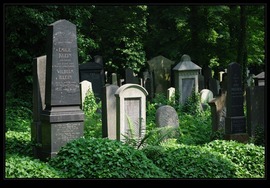 Founded in the first half of the 15th century, it belongs among the most significant preserved monuments of Prague's Jewish Town, alongside the Old-New Synagogue. The oldest tombstone, of the scholar and poet Avigdor Karo, dates back to 1439. The last burial here took place in 1787.
Founded in the first half of the 15th century, it belongs among the most significant preserved monuments of Prague's Jewish Town, alongside the Old-New Synagogue. The oldest tombstone, of the scholar and poet Avigdor Karo, dates back to 1439. The last burial here took place in 1787.
Today, almost 12 000 tombstones can be found here, but the number of the buried people is certain to have been higher. The most significant person buried in the Old Jewish Cemetery is undoubtedly the great religious scholar and pedagogue Jehuda Liwa ben Becalel, called Rabbi Loew (he died in 1609), a figure linked to the legend about the creation of an artificial being - a golem.
The Spanish and Old-New Synagogue
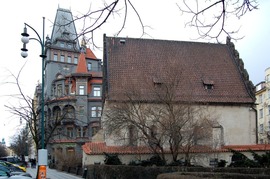 From time immemorial, Prague has been connected with the Jewish community. According to historical sources, the first record of Jewish inhabitants of Prague is from the year of AD 1200, but Jews are likely to have lived here well before that. The Old-New Synagogue is the longest-serving synagogue in the world.
From time immemorial, Prague has been connected with the Jewish community. According to historical sources, the first record of Jewish inhabitants of Prague is from the year of AD 1200, but Jews are likely to have lived here well before that. The Old-New Synagogue is the longest-serving synagogue in the world.
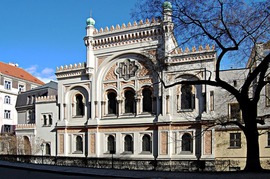 And not only that – it is the second oldest in the whole world. Built in the first half of the 13th century, it is also one of Prague's early Gothic monuments. On the site of the oldest Prague Jewish prayer house, called “the Old Shul”, the Spanish Synagogue was built in 1868 in the Moorish style according to the project by Vojtěch Ignác Ullmann a Josef Niklas. The synagogue has a rectangular central plan with a dome surmounting the central space.
And not only that – it is the second oldest in the whole world. Built in the first half of the 13th century, it is also one of Prague's early Gothic monuments. On the site of the oldest Prague Jewish prayer house, called “the Old Shul”, the Spanish Synagogue was built in 1868 in the Moorish style according to the project by Vojtěch Ignác Ullmann a Josef Niklas. The synagogue has a rectangular central plan with a dome surmounting the central space.


















